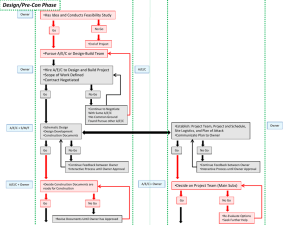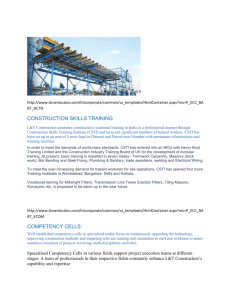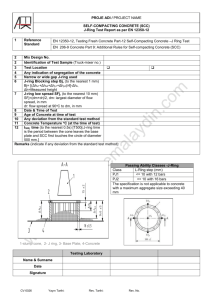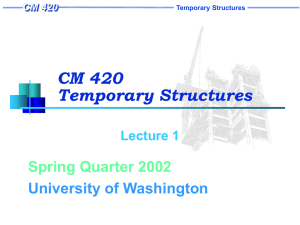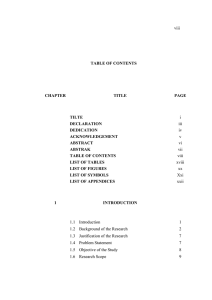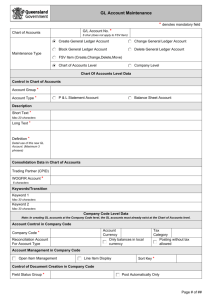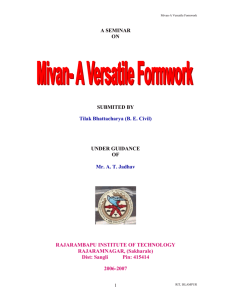Motivation
advertisement
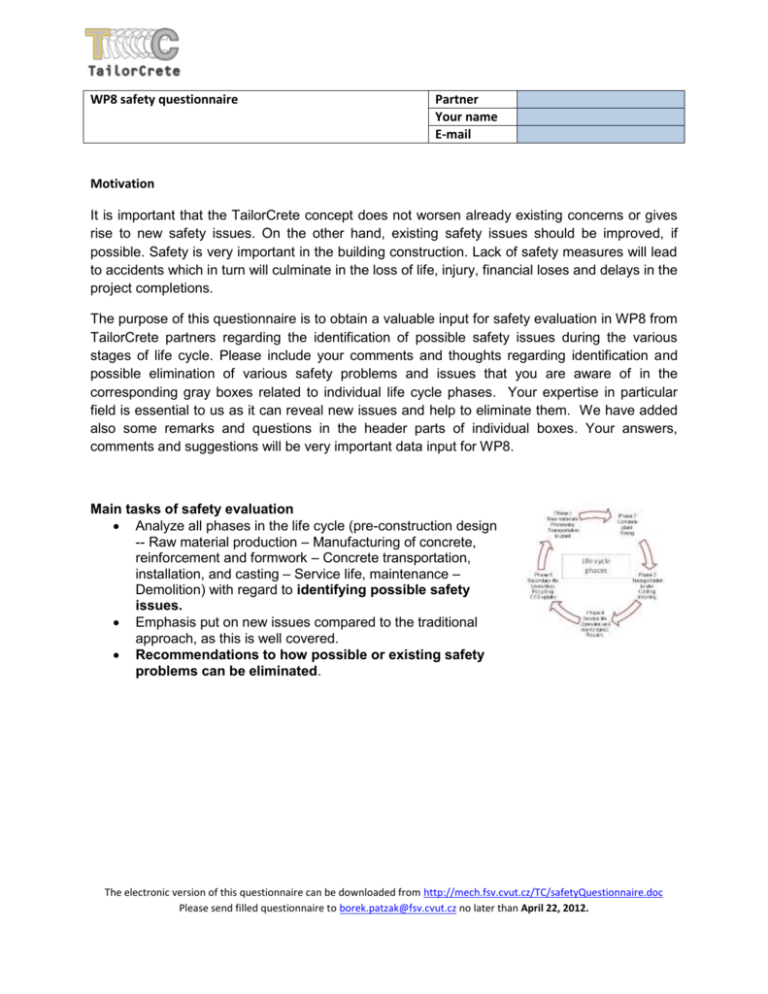
WP8 safety questionnaire Partner Your name E-mail Motivation It is important that the TailorCrete concept does not worsen already existing concerns or gives rise to new safety issues. On the other hand, existing safety issues should be improved, if possible. Safety is very important in the building construction. Lack of safety measures will lead to accidents which in turn will culminate in the loss of life, injury, financial loses and delays in the project completions. The purpose of this questionnaire is to obtain a valuable input for safety evaluation in WP8 from TailorCrete partners regarding the identification of possible safety issues during the various stages of life cycle. Please include your comments and thoughts regarding identification and possible elimination of various safety problems and issues that you are aware of in the corresponding gray boxes related to individual life cycle phases. Your expertise in particular field is essential to us as it can reveal new issues and help to eliminate them. We have added also some remarks and questions in the header parts of individual boxes. Your answers, comments and suggestions will be very important data input for WP8. Main tasks of safety evaluation Analyze all phases in the life cycle (pre-construction design -- Raw material production – Manufacturing of concrete, reinforcement and formwork – Concrete transportation, installation, and casting – Service life, maintenance – Demolition) with regard to identifying possible safety issues. Emphasis put on new issues compared to the traditional approach, as this is well covered. Recommendations to how possible or existing safety problems can be eliminated. The electronic version of this questionnaire can be downloaded from http://mech.fsv.cvut.cz/TC/safetyQuestionnaire.doc Please send filled questionnaire to borek.patzak@fsv.cvut.cz no later than April 22, 2012. 1. Pre‐construction phase – design The safety of design process itself will have to be ensured by corresponding codes, and will be covered by WP9. However, many additional safety aspects can be improved already during design phase: Design to reduce Health hazards: Improving safety by using materials that are easier to handle, e.g. lightweight building blocks, limiting the weight of formwork for easier handling. Design to reduce Hazardous work: Prefabrication can be considered to minimize hazardous work on site by designing elements like steel structures so that they can be prefabricated and assembled on ground and then lifted to position for installation; Specifying cutting of steel members to be done off-site, under controlled conditions, to reduce the amount of dust created; and Reducing site welding so as to reduce fire or burn risks and using prefabricated bolt and nuts as connections. Design to safe construction: Providing lifting points on prefabricated elements and marking the weight and the center of gravity of heavy or bulky items both on the drawings and on the items themselves; Making provision for temporary works required during construction; Designing connections to minimize risk of incorrect assembly and providing clear directions on drawings; and Designing for safe installation of external cladding i.e. installation of cladding from the inside of the building. Design to simplify future: Using materials that require less frequent maintenance or replacement; The risks related to maintenance and repair of the building, such as the cleaning methods, should also be considered. Design to reduce demolition hazards: Sources of substantial stored energy, such as pre- or posttension cables; Unusual stability concepts; Alterations that have changed the structure significantly; and Embedded materials, utilities, or artifacts whose exposure or removal may introduce new hazards. The safety and reliability of SCC depend very much on quality assurance procedure, test methods, frequency of test as well as of actions taken as results of tests. The planning should also address the corrections of the mix that might be done at the casting site through extra dosage of plasticizer. How the quality of mixed SSC will be verified, including fiber content and distribution? 2. Raw material production, processing, transportation Material Safety: Will SCC use lead to utilization of new, potentially, hazardous materials? (Viscosity modifiers, formwork release agents, etc.). Please identify any new hazardous substances and provide information on its composition, properties, and procedures for handling or working with that substance in a safe manner by filling in attached material safety data sheet (MSDS). MSDS information also includes instructions for the safe use and potential hazards associated with a particular material or product. Note: Mix designs are likely to include more than one admixture and more than one mineral additive. This will require additional installations as well as proper processes for batching. To further optimize the processing and the quality, an improved handling of the aggregate, e.g. in the form of split fractions will be common practice. A close control of the aggregate moisture is also enhancing quality and cost efficiency. Will this induce some safety issues, compared to traditional concrete? The electronic version of this questionnaire can be downloaded from http://mech.fsv.cvut.cz/TC/safetyQuestionnaire.doc Please send filled questionnaire to borek.patzak@fsv.cvut.cz no later than April 22, 2012. 3. Concrete, reinforcement and prefabricated formwork manufacturing Quality Management to ensure safety: Considerations of quality cover all aspects of a system’s life and are therefore of great importance to fault management. Worker safety: formwork, casting and stressing operations are adequately braced and chocked to avoid sudden release of materials. Are new tools, training or protective equipment necessary? Working environment: Will use of SCC use lead to improvement in working environment? Is the use of robots planned on construction site or robots will operate in a dedicated plant and products transported and assembled on site? Are there additional safety concerns, related to this? New formwork types: Are you aware od new safety issues connected to new formwork types used? Will the assembly of formwork bring new safety issues (work in confined space, manipulation of bulky items, spraying)? Are additional training, regulations, or protective tools needed? Is formwork design redundant to assure fault tolerance? The high flow ability of SCC can result in flotation of any buoyant formwork units, stop ends or detailing that is not securely fixed. Particular attention should be given to fixing and sealing the formwork to the base where uplift could be a problem. Leakage at joints can occur and reduce an otherwise high quality of finish, however SCC generally leaks less than concrete that has to be vibrated. Robotic manufacturing: Will robot use in formwork and reinforcement production bring in new safety issues. SCC production: As the SCC mixture properties are very sensitive to variations of inputs (compared to traditional concrete), can this be considered as potential safety issue? What kind of safety regulations and quality assurance procedures should be applied to minimize the effects? The electronic version of this questionnaire can be downloaded from http://mech.fsv.cvut.cz/TC/safetyQuestionnaire.doc Please send filled questionnaire to borek.patzak@fsv.cvut.cz no later than April 22, 2012. 4. Transportation, installation, concrete casting, surface finish Concrete casting: Careful quality control and proper design of CSS composition necessary to avoid air entrapments, segregation. etc. Improvements in working environment: Drastic improvement when using SCC. Reduction of noise level and avoidance of blood circulation disturbance (white fingers) induced by handheld vibrators. No need for the installation of vibration isolators anymore? Improved safety through more mechanization and remote control. Substantial reduction of hazardous objects e.g. elevated platforms, cables, vibrators. The process of casting SCC can be mechanized to a great extent. Increased productivity, lower cost and improved working environment is achieved. The elimination of manual compaction during casting makes very high casting rates possible which, in combination with the high flow ability, might cause high formwork pressures. In situ robots: Do we consider the utilization of robots in building site for final formwork assembly, reinforcement placement, etc? If yes, many new safety issues will arise. SCC is a complex material with several sensitive interactions between the constituent materials. Compared to vibrated concrete it is at this stage of development less robust and requires more knowledge, competence and skill of personnel, more closely controlled properties of the constituent materials and greater care in production and delivery. The technology also requires greater skill and care in the casting operation. These conditions call for an increased focus on training of personnel and on quality assurance issues. 5. Service life, maintenance Can the use of fiber-reinforced concrete improve the safety with respect to fire? (Possible reduction of spalling). Also, the increased ductility of fiber reinforced structures can improve safety in many areas (earthquakes). Also a strong reduction in permeability is expected due to the high content of fines in the mix. In general SCC has shown to give improved microstructural features leading to potential improvements of strength, durability and surface quality. 6. Demolition, recycling Could fibers be recycled and how this compares to recycling of traditional reinforcement? Are there any new safety issues? The electronic version of this questionnaire can be downloaded from http://mech.fsv.cvut.cz/TC/safetyQuestionnaire.doc Please send filled questionnaire to borek.patzak@fsv.cvut.cz no later than April 22, 2012.



